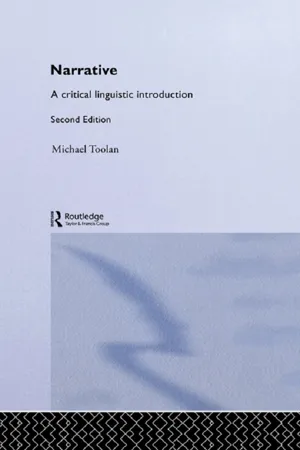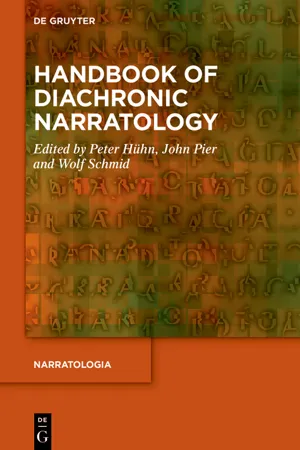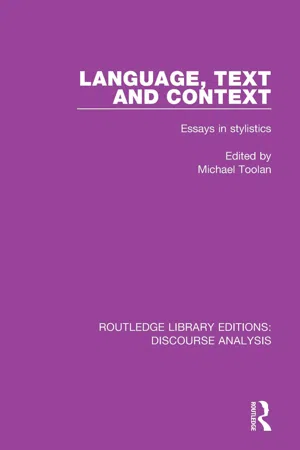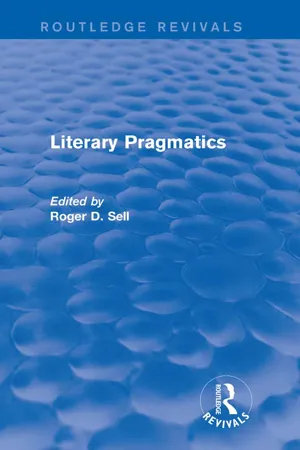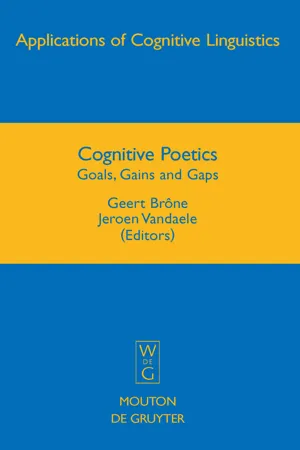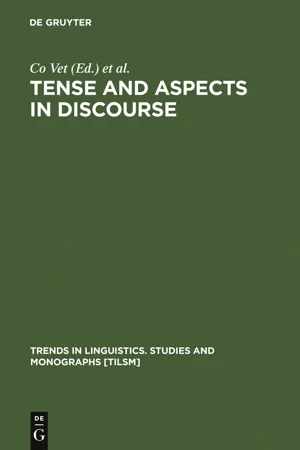Literature
Free Indirect Discourse
Free indirect discourse is a narrative technique that blends a character's thoughts or speech with the narrator's voice, creating a seamless transition between direct and indirect speech. It allows readers to experience the character's perspective while maintaining the narrative's overall voice. This technique is commonly used in literature to provide insight into characters' emotions and motivations.
Written by Perlego with AI-assistance
Related key terms
1 of 5
9 Key excerpts on "Free Indirect Discourse"
- Monika Fludernik(Author)
- 2003(Publication Date)
- Routledge(Publisher)
A lack of delimitation between the narrator’s and the characters’ language, or a very pronounced citation of characters’ linguistic peculiarities, may serve a large variety of idiosyncratic effects that depend on the situational, narratological and ideological (macro-) context. The uses of Free Indirect Discourse in George Eliot (D.A.Miller 1988), in Zora Neale Hurston’s Their Eyes Were Watching God (Gates 1989) or in Madame Bovary (LaCapra 1982) cannot be reduced to a grammatical shape and might conceivably be produced by entirely different means (authorial commentary, narrative discontinuities, etc.). Free Indirect Discourse indeed frequently contributes to, rather than directly causing, certain macro-structural situations, for instance the prevalence of figural narrative, or the evocation of dead-pan irony (Fludernik 1992b). If the question of function is therefore dismissed in the present study, this has been done in the interests of the theoretical purposes of this volume alone; in the interpretation of individual works of narrative that question will remain of prime importance. A second lacuna concerns the much-discussed question of point of view or (figural) perspective. Narratologists have treated this problem primarily in typological terms, establishing focalization either as perceptional and ideological viewpoint anchored in narratological instances (the narrator or a character), or as camera-like focussing on external and internal sense data and controlling the accessibility of such sense data (Bal 1985). Stanzel (1984b) combines enunciational (teller versus reflector character), existential (realms of existence) and purely perspectival choices to establish his three narrative situations, and other critics (Füger 1972, Lanser 1981, Bonheim 1982a) dissect narrational constellations into an entire substructure of collocational elements- eBook - ePub
Narrative
A Critical Linguistic Introduction
- Michael Toolan(Author)
- 2012(Publication Date)
- Routledge(Publisher)
In broad terms, then, DD and ID may be said to differ in their effect on the reader. Usually the reader feels a greater distance and detachment from characters and their words when these are mediated via Indirect Discourse. DD is an environment where characters appear to be in control and speak for themselves, while in ID the narrator is more overtly still in control, and reports on behalf of the characters. But the appearance or illusion of character control should not be overstated: behind all the fictional individuals, however reported, stands the controlling teller, as is made newly vivid when, for example, stretches of direct speech are set in sharply evaluative framing contexts (see Fludernik (1993) and Sternberg (1982) for discussion).But if character vividness and seeming autonomy are potential corollaries of DD reporting, then equally ID becomes positively desirable when a narrator judges that projecting such vividness is not appropriate. This might be because the topic of speech or thought is mundane, or has already been recorded earlier in the narrative. Or it may be that projecting character depth, authenticity and autonomy is inappropriate because the particular character is quite minor in the larger story, and it would be misleading to endow them with so much individuality. On other occasions, including a second reporting of thought or talk more fully presented previously, something even more abridged than ID is desirable: an entire phase of a relatively unimportant conversation or meeting or telephone call or mental assessment needs to be condensed into a sentence or two, on the grounds that a fuller telling would be aesthetically ill-advised. Those are the occasions on which NRTA or NRSA will be most suitable.5.4 Different again: Free Indirect Discourse
The narratorially most fascinating styles of discourse reporting, however, are those that appear to lie between orthodox Direct and Indirect Discourse, revealing some of the formal features of each of those two formats. If we list again the six major contrasts between DD and ID, in abbreviated form: - eBook - ePub
- Peter Hühn, John Pier, Wolf Schmid, Peter Hühn, John Pier, Wolf Schmid(Authors)
- 2023(Publication Date)
- De Gruyter(Publisher)
Free Indirect Discourse in Medieval and Modern French Literature
Sophie Marnette1 Definition
Based on Oswald Ducrot’s theory of enunciation (1984 , 1989 ), Free Indirect Discourse (FID) can be defined as a unique enunciative act in which the locutor (responsible for the enunciative act and denoted where necessary by je) reports the perspective of another speaker (the enunciator) in his discourse without it being explicitly indicated in the utterance that said perspective is being reported. In other words, the speaker neither subordinates the enunciator’s discourse to a declarative verb nor coordinates it with another subordinate reported discourse, even though subordinated reported discourse (expressed in Indirect Discourse, ID) can be found in the co-text immediately preceding the FID. Contrary to what occurs in ID, the locutor and the enunciator whose perspectives are reported are not confined to any specific part of the utterance. In narrative terms, FID is thus a device by which the narrator/locutor integrates a character’s/enunciator’s discourse into his own speech without interrupting the flow of the story – that is, without having to open quotation marks or employ an introductory formula for Direct Discourse (DD).In modern French, FID is characterized by the presence of features of DD (direct questions, exclamations, deictics, and colloquialisms attributed to the quoted locutor, etc.) reported in the fashion of ID entailing the shifting of pronouns and tenses to refer to the quoting locutor, but without syntactic dependency on a reporting clause and thus without direct subordination to a verbum dicendi or sentiendi or coordination with a previous reported clause. Certain shifters such as ici (here), maintenant (now), and aujourd’hui - eBook - ePub
Language, Text and Context
Essays in stylistics
- Michael Toolan(Author)
- 2016(Publication Date)
- Taylor & Francis(Publisher)
Part II Strategic styles DOI: 10.4324/9781315402383-10Passage contains an image
5 Free Indirect Discourse in the eighteenth-century English novel: speakable or unspeakable?
The example of Sir Charles GrandisonAnne Waldron NeumannDOI: 10.4324/9781315402383-12This essay has several purposes. It confirms that Free Indirect Discourse is indeed ‘double-voiced’ (as in Bakhtin, 1984 : 190) but suggests that this double voice is not unique to literary narrative. It therefore also counters the tendency to seek linguistic differences between fictional, literary narratives, and other kinds of discourse. It demonstrates what has been neglected – that Free Indirect Discourse is already widespread in eighteenth-century fiction. Since I argue too that Free Indirect Discourse is often easily identifiable and attributable in eighteenth-century fiction, my essay implies that, though the ambiguity of Free Indirect Discourse may be its most intriguing feature, Free Indirect Discourse, even in later fiction, is not always undecidable. Finally, as I discuss Free Indirect Discourse in one particular eighteenth-century novel, Sir Charles Grandison, I suggest why reported discourse in general is so prevalent in this novel and others like it – why it supports the novel’s moral endeavour. The way characters in this and similar novels remember and quote from each other, with or without attribution, suggests how some eighteenth-century novelists hoped to be remembered and assimilated by readers – indeed, how readers do sometimes remember and assimilate their reading.According to most definitions, free (as opposed to tagged) indirect discourse quotes speech or thought indirectly but omits the tag or inquit – the ‘John said’ or ‘Jane thought’ – that both identifies what follows as quotation and attributes it to a particular source. Like tagged indirect discourse, Free Indirect Discourse shifts pronouns and verbs to fit the quoting speaker’s perspective but, typically, retains any other indicators of the here-and-now of the quoted speaker as well as independent-clause word order. Below are typical examples (following Chatman 1978 ) of tagged and free direct and indirect discourse. Note that Free Indirect Discourse, hereafter FID, comprises both free indirect thought and free indirect speech (to see what free indirect thought looks like, substitute ‘John asked himself for ‘John asked Jane’ in the examples below). In this essay, however, I shall discuss only free indirect speech, out of which, I hypothesize, free indirect thought evolved. (Moreover, I shall ignore a distinction between free direct - eBook - PDF
- H. Porter Abbott(Author)
- 2020(Publication Date)
- Cambridge University Press(Publisher)
Also, because it is so fluid, Free Indirect Discourse can at times present quite a challenge for interpreters who are trying hard to locate a unified sensibility on which to base their interpretation. Stream of Consciousness and Interior Monologue Here are two terms that are often used interchangeably for a technique that is close to Free Indirect Discourse. It is most useful, though, to keep all three terms as distinct as possible. “Stream of consciousness” is a phrase first used by William James in 1892 to describe the way we experience consciousness (as a continual stream of associated thoughts, without rational ordering and permeated by changing feelings). “Interior monologue” was first used almost at the same time by the French novelist Édouard Dujardin in his novel Les lauriers sont coupés (1887) to describe a technique of free direct (not indirect) discourse in representing the stream of consciousness of his characters. Early in this century, Dorothy Richardson, Virginia Woolf, James Joyce, William Faulkner, and others began experimenting with stream-of-consciousness novels in which the flow of consciousness of one or more characters was the principal focus. Narration on Stage and Screen 85 Narration on Stage and Screen Narration through a narrator, though not the rule in either film or theater, has been deployed often enough in these media. Plays like Thornton Wilder’s Our Town (1938) and films like Murder My Sweet (1944) and Stanley Kubrick’s A Clockwork Orange (1971) make highly effective use of a narrator. The major difference in effect between narration in these media and narration in print or through oral storytelling is the degree to which the presence of visual imagery absorbs attention. This is especially the case in film, where narration is most frequently voice-over narration in which a disembodied voice is heard in tandem with imagery that is often conveying in its own way incidents of the story. - eBook - ePub
Life Storying in Oral History
Fictional Contamination and Literary Complexity
- Jarmila Mildorf(Author)
- 2023(Publication Date)
- De Gruyter(Publisher)
9 Conveying People’s Thoughts: Mind Representation and Free Indirect DiscourseIn the previous chapter, I attended to focalization as a literary concept that may also be useful in analyzing narratives in non-fictional contexts. Focalization, which answers the question “Who sees?”, entails perception in general, including all the senses: visual, auditory, tactile, olfactory, gustatory. Readers or listeners are invited to imagine all the sensual aspects of the presented storyworld. However, focalization as it is used in literary studies usually also encompasses the question how these sense perceptions are processed in characters’ minds. That is, thought and mind representation is one significant subcategory of focalization and, as I demonstrate in this chapter – which draws on Mildorf (2008) – it also plays an important role in oral history narratives.In literary narrative, at least if one follows the speech category approach, i.e., the approach that models thought representation in analogy to speech representation, thought can generally be presented in one of three ways: as direct thought, thought report, or free indirect thought (Palmer 2004 : 54)1 :a) She thought, Where am I? (direct thought) b) She wondered where she was. (thought report)c) She stopped. Where the hell was she? (free indirect thought)What can be seen in example (c) is an instance of free indirect thought or Free Indirect Discourse (subsequently abbreviated as FID), also called discours indirect libre and erlebte Rede in French and German. We have here a peculiar mixture of the narrative voice and the subjectivity of the presented character or, in Hernadi’s (1972) terms, “the narrator substitutes his words for a character’s speech, thought, or sensory perception” (35). While the sentence still belongs to the narrative on account of its third-person narrative situation and its continued use of past tense, the direct interrogative clause and the colloquial expression “the hell” point towards the character’s subjective feelings in this situation and can be regarded as a transformation of her original thought: “Where the hell am I?” More finely grained typologies with further distinctions and intermediary steps have been proposed, for example, by McHale (1978, 2005) or Fludernik (1993a) - eBook - ePub
- Roger D. Sell(Author)
- 2014(Publication Date)
- Taylor & Francis(Publisher)
4 How Indirect Discourse Means Syntax, semantics, poetics, pragmatics Meir SternbergDOI: 10.4324/9781315735849-5Discourse, Reported Discourse, Indirect Discourse
Like that of poetics, the business of pragmatics is discourse; and discourse is a piece of language that represents a piece of world from a certain viewpoint or framework. A form of words, an image of reality, a point of view, including all the orientational parameters usually subsumed under the term ‘context’; a linguistic how, a mimetic, referential what, a communicative whence-and-why. Reported or quoted discourse entails the very same components, but with a set of distinctive features that amount to what I call the universals of quotation (see especially Sternberg 1982a ). To see those peculiarities at work, it is enough to glance at the following examples, Biblical and modern, of direct, indirect, and Free Indirect Discourse respectively:-
(a) They [the priest of Midian’s daughters] came to their father Reuel and he said, Why have you come early today? They said, An Egyptian delivered us out of the hand of the shepherds and also drew water for us. (Exodus 2:18–19)1(b) He kissed her good night. She asked, ‘Where are you going?’ (Greene 1962 : 33)
-
(a) The people heard that [ki] the Lord had visited the Israelites and that He had seen their affliction. (Exodus 4:31)2(b) ‘My dear Mr. Bennet,’ said his lady to him one day, ‘have you heard that Netherfield Park is let at last?’Mr. Bennet replied that he had not. (Austen 1961[1813] : 5)
-
(a) The watchman went up to the roof of the gate by the wall, lifted up his eyes and saw, and behold, a man [was] running alone. (II Samuel 18:24)
3(b) They would, she thought, however long they lived, come back to this night; this moon; this wind; this house; and to her too. (Woolf 1964[1927] : 130)
- (c) Jephthah came to his home at Mizpah, and behold, his daughter [was] coming out to meet him with timbrels and dances. (Judges 11:34)
- eBook - PDF
Cognitive Poetics
Goals, Gains and Gaps
- Geert Brône, Jeroen Vandaele, Geert Brône, Jeroen Vandaele(Authors)
- 2009(Publication Date)
- De Gruyter Mouton(Publisher)
Judging distances 347 right now, if only it “weren’t so artificial, / Such a deliberate step back-wards”. Poems with similar typified quotes include “Self’s the Man” and “Sympathy in White Major”, both in their own way reflections on the tug between self and society (cf. Vandelanotte 2002: 412–418). These are, then, the main uses to which direct discourse is put in Lar-kin’s poetry: to indicate what could have been said but (perhaps) wasn’t, or to give representative examples of the type of thing usually said in a given scenario or frame (e.g. when people walk out on their lives, in a marriage, at a funeral). In either case, we would argue that direct discourse, with the shift to a new mental “base” space it involves, is used in a general sense to “illustrate a point”. Similar functions were ascribed to direct speech or thought by Mayes (1990) and Holt (1996), who apart from its dramatizing function (adding to the “liveliness” of the discourse) discussed the use of direct discourse to provide evidence in a clear and economical way: rather than explaining laboriously what a speaker’s claim, opinion or state of mind is, one can immediately conjure this up by quoting her. Compared with DIST, to which we will turn below, the attitudinal effect in these cases of “evoked” direct discourse is less immediate, in the sense that the unspoken or typical utterances conjured up in it are not as such criticized or debunked, but illustrate the poem’s persona’s point. The current speaker’s appropriation of another’s discourse in DIST, on the other hand, always simultaneously involves the former’s often critical attitude towards the represented utterance, for instance of incredulity or irony. This is not to say, of course, that within the discourse context the views of the poem’s persona may not contradict those represented in di-rect discourse. - eBook - PDF
- Co Vet, Carl Vetters, Co Vet, Carl Vetters(Authors)
- 2011(Publication Date)
- De Gruyter Mouton(Publisher)
As for free indirect style, it should have been studied for its own sake instead of in support of some rather improbable hypothesis. At first sight the conclusion of this paper seems to be rather negative. All criteria that are proposed to distinguish free indirect style from narration have proven to be misguided. Let us note however that those problematic examples where ambiguity cannot be resolved, only constitute a minor part of the whole corpus of free indirect style occurrences. In most cases there is no doubt whatsoever and the reader chooses effortlessly the right interpretation. We have seen in 2. that one cannot account for this interpretation on the syntactic level of the sentence; but one can do so at the level of discourse, guided by Banfield's (1982) principle: 1 Expression / 1 Speaker. Each utterance comes from one and only one speaker. If our world knowledge or contextual indi-cations prevent us from ascribing an utterance to the author, we have to ascribe it to one of the characters (thus free indirect style) and vice versa: whenever a sentence cannot be ascribed to one of the characters it has to originate from the author. Ambiguous sentences are those where the same passage can be ascribred to each of them, though not to both at the same time. Notes 1. We have completed these examples constructed by Lips on the basis of an extract of Perrault. 2. Cornulier (1978:53) gives the following definitions: Appelons par convention verbes parenthetiques les verbes qui peuvent figurer dans une incise en fransais de bon usage; et incises inverties; ou simplement ici incises, les expressions du type de celles qui suivent la citation dans Oui, (dit-il + fit-elle + soupira-t-il + l'encouragea-t-elle),
Index pages curate the most relevant extracts from our library of academic textbooks. They’ve been created using an in-house natural language model (NLM), each adding context and meaning to key research topics.

